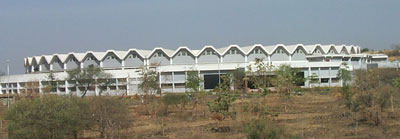Raja Ramanna Centre for Advanced Technology is a unit of Department of Atomic Energy, Government of India, engaged in R & D in non-nuclear front line research areas of Lasers, Particle Accelerators & related technologies.

RRCAT was established by the Department of Atomic Energy, India to expand the activities carried out at Bhabha Atomic Research Centre (BARC), Mumbai, in two frontline areas of science and technology namely Lasers and Accelerators.
On February 19, 1984 the President of India, Gyani Zail Singh, laid the foundation stone of the centre.
Construction of laboratories and houses began in May 1984.
In June 1986, the first batch of scientists from BARC, Mumbai, moved to RRCAT and scientific activities were started.
Since then, the centre has rapidly grown into a premier institute for research and development in lasers, accelerators and their applications.
The RRCAT campus is spread over a 760 hectare picturesque site on the outskirts of Indore city. The campus encompasses laboratories, staff housing colony and other basic amenities like school, sports facilities, shopping complex, gardens etc.
Research Activities
Accelerator
The Centre has indigenously designed, developed, and commissioned two synchrotron radiation sources: Indus-1 and Indus-2, serving as a national facility. Indus-1 is a 450 MeV, 100 mA electron storage ring emitting radiation from mid-IR to soft x-ray with a critical wavelength of ~61 Å. Indus-2 is a 2.5 GeV electron storage ring designed for the production of x-rays. Synchrotron radiation emitted from its bending magnets has broad spectrum covering soft and hard x-ray regions with a critical wavelength of ~2 Å. With its circumference of 172.5 m, and beam energy of 2.5 GeV, Indus-2 is presently the largest and the highest energy particle accelerator in the country.
The Centre is pursuing several other key accelerator activities viz. development of a high energy proton accelerator for a spallation neutron source, electron accelerators for food irradiation and industrial applications, free electron lasers (FEL) in terahertz (THz) and infra-red (IR) spectral region, superconducting and magnetic materials required for accelerators, development of advanced technologies such as superconducting radio-frequency (SCRF) cavities and cryomodules, high power radio-frequency (RF) generators, cryogenics, magnets, ultrahigh vacuum, precision fabrication and control instrumentation to support the various R&D programmes.
Laser
The Centre is also involved in development of a variety of laser systems and their utilization for applications in industry, medicine and research. The laser systems developed include high power CO2 lasers, flash lamp and diode laser pumped Nd lasers, semiconductor lasers, chemical lasers, excimer lasers and high energy/intensity pulsed lasers. Crystals of a variety of materials of interest to laser technology have been grown. The industrial applications being pursued include cutting, drilling, welding, surface modifications and rapid manufacturing. Various laser based instruments such as uranium analyzer, land leveler, compact N2 laser, photo-coagulator, fibre based temperature sensor, surgical CO2 laser system have been developed. Home-made and commercial lasers are being used for research in the areas of laser plasma interaction, laser-based charged particle acceleration, laser cooling and trapping of atoms, nonlinear optics, ultra-fast dynamics, material processing, laser fluorescence spectroscopy of tissues, effects of narrow bandwidth light on cells and animal models, imaging through turbid media, laser micromanipulation of microscopic objects etc.
Organization Chart
| Working Hours in RRCAT |
| Time |
09:00 AM to 05:30 PM |
|














